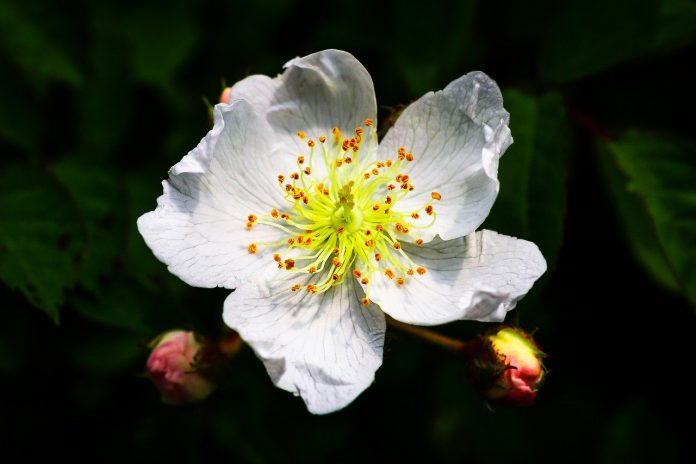Growing up, multiflora rose was one of those four-letter words in my house. This plant was introduced to the United States in the 1860s and promoted as a way to prevent erosion, establish “living fences” and provide rootstock for ornamental roses.
If you have run across this plant, you understand that the best intentions of those who introduced it have run amuck. According to Research Note NRS-182 from the U.S. Forest Service, the plant is now found throughout much of the United States and Canada, restricts growth of preferred plants and forms dense thickets with large thorns that most pasture animals, and many farm workers, will not brave.
To add to the issue, the shrub can produce 1 million seeds per year that can remain viable in the soil for 20 years and also reproduces by layering, where the stem of the plant can form roots at any points where it touches the ground.
Invasive
My family farm’s most hated plant is considered an invasive plant. An invasive plant is described as, “a species that is non-native (or alien) to the ecosystem under consideration; and, whose introduction causes or is likely to cause economic or environmental harm or harm to human health” by the U.S. Department of Agriculture.
With modern transportation, and the habit of invasive plants to spread quickly, I am certain that every piece of farmland in Ohio has its own version of plants that do not belong that they deal with. Managing invasives can be difficult for many reasons. As new plants are introduced to an area, either for a specific reason or if they accidentally hitch a ride on equipment, they can establish quicker than any plant that is desired.
Some invasive plants can cause physical harm to humans and animals, including poison hemlock and wild parsnip. Some cause loss of land for production, including multiflora rose and autumn olive. Others compete with plants being cultivated for production, including some brome and thistle varieties.
Some, like tree of heaven (Ailanthus} serves as host to other invasive species like the spotted lanternfly, which is has been found in parts of Ohio and is making quick headway in the state.
There are numerous reasons that invasive plans and animals quickly become problems. Conditions they are introduced into often provide them with conditions where they can produce quickly. They do not have to deal with native predators, host species, diseases, or life cycles that often serve to control populations in their native locations.
So how do landowners deal with invasive species? There are a few methods that can help, but I am afraid there are seldom any magic answers for these issues.
Identification
The first step in controlling invasive populations is to be able to properly identify them. Pasture walks and inspections are vital for many reasons and knowing where you may have unwanted plants taking root is among them.
For example, one Palmer amaranth plant can produce between 100,000 and 500,000 small seeds that are well adapted to no-tillage conditions. If you have one of these plants near a fence line bordering a road, in one to two years, you could lose a significant section of your available pasture to the plant.
Search extension resources at Ohioline.osu.edu or visit the Ohio Invasive Plants Council webpage for information on invasive identification in your area.
Branch out
Branching out in your production practices can be a benefit in controlling invasives. Research from the University in Missouri showed that adding goats to the grazing plan helped to control non-native and unwanted stands of lespedeza in their trials.
Cattle had avoided the plant due to bitter taste and woody stems of mature plants. Goats are browsers will often eat items grazing animals avoid. The goats also benefited because lespedeza also served as a natural anti-parasitic due to the tannins produced by the plant. While it is a native plant, we have noticed that our goats love to eat poison ivy, which is a bonus to this allergic educator.
Some invasive plants are actually a good source of nutrition, including goldenrod, Canada thistle, spotted knapweed and milkweed, but grazing animals do not eat them. A long-term study from Utah State University showed that eating is a learned behavior from mothers and herd mates, along with their body reactions to plants. Teaching animals to eat invasive plants can be a time-consuming process to start, but once some “trainees” get the idea, they will spread the word in your herds.
The idea is to not force animals into eating something by depriving them, but introducing new items over time, often enhanced by treats of things such as molasses to entice animals to try new things. Think of Mary Poppins’ “A Spoonful of Sugar” method. Slowly introduce new items into a mix of familiar ones and increase until they are eating what you do not desire.
Mowing
While it may not fit well in your pasture management plans, close mowing can help control several invasive plants, including milkweed and hemp dogbane. But mowing closely must be repeated several times to experience some control and must be completed before the plant goes to seed.
Making sure equipment has been cleaned between fields can help slow the movement of unwanted plants, especially equipment that has been used to mow these target areas. Research is ongoing on methods of chemical and other controls as plants find footing in new areas.
As with most things in farming, there are no simple solutions to this issue. Planning and research will help arm farmers and landowners to handle issues in line with their management plans. If you have questions about best practices, or would simply like more information on this topic, please contact your local extension office.













